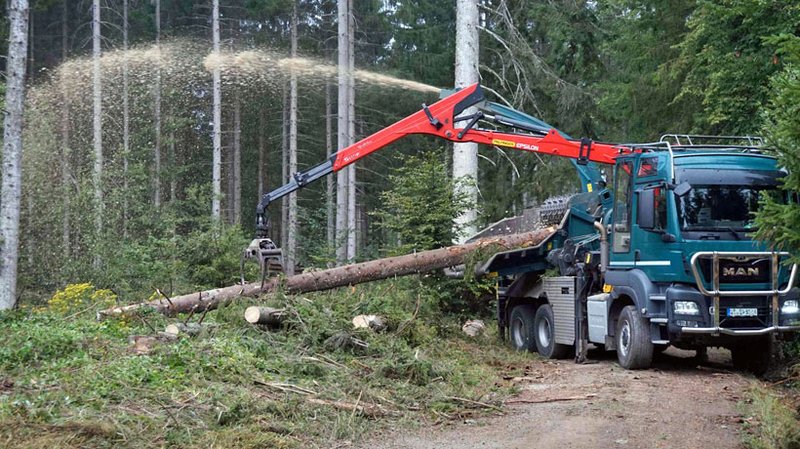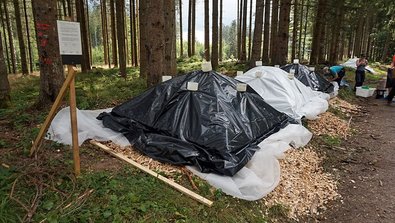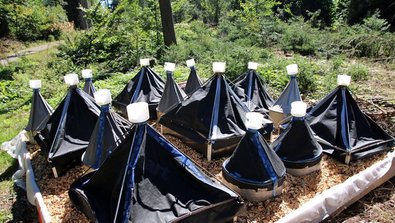Initial situation
Again in 2020, integrated bark beetle management was the central task of forest protection. The bark beetle population densities were already high. Hurricane Sabine and further water shortages again later on meant that in some areas, there were large numbers of weakened spruce trees available as ideal breeding grounds for the beetles.
In some cases, the timber market could no longer absorb the quantities of infested and processed timber, so that it was not always possible to remove the timber from the forest before the bark beetles flew out of it.
Since the use of plant protection products as a last resort was not always possible or desired, infested trunk wood was also chipped to treat it for bark beetles (Fig. 1), sometimes without the chips being used thermally as would usually be the case. In the late summer of 2020, a trial was carried out to test the effectiveness of this mechanical forest protection procedure in the southern Black Forest. In addition to the effects of the mechanical chipping process on the two important bark beetle species on spruce, the European spruce bark beetle, also known as the European eight-toothed spruce bark beetle (Ips typographus), and the smaller European spruce bark beetle, also known as the smaller European six-toothed spruce bark beetle (Pityogenes chalcographus), the potential effect of raising the temperature of the woodchip piles by covering them with black silage-wrapping film was investigated. It was also checked whether bark beetles still fly from wood chips spread out on the ground (Fig. 2).
Results
Bark beetles were still able to fly out of all of the wood chip piles, as well as out of the wood chips blown over an extensive area. The number of European eight-toothed spruce bark beetles was however so low in all cases, that chipping can be seen as an effective treatment for this species of bark beetle. The picture was rather different for the smaller European six-toothed spruce bark beetle: In some cases, a large number of six-toothed spruce bark beetles were counted both in piles of woodchips and in woodchips blown over a large area. In several procedures, the number of six-toothed bark beetles counted exceeded the number of six-toothed bark beetles that flew from the unchipped logs that served as a control procedure. In these cases, the chipping procedure had an adverse effect, i.e. it resulted in higher numbers of beetles flying out, at least during the observed trial period. It was also shown that the smaller European six-toothed spruce bark beetle continued to develop from the white stages to the juvenile beetle stage within the piles.
By recording the temperatures inside the wood chip piles during the trial period from mid-August to October, it was shown that lethal temperatures for the bark beetles were not reached even when the piles were covered with black foil. Evidence of an initially suspected fermentation process ("composting effect") could not be found.
Recommendations
The results presented show the importance of differentiating between the bark beetle species for the purpose of evaluating the chipping of infested logs as a mechanical procedure to protect the forest against bark beetles.
With regard to the European eight-toothed spruce bark beetle Ips typographus, chipping can generally be recommended as a treatment for bark beetle infestation. Nevertheless, here too, it is recommended that the woodchips are piled up in heaps, if possible, and covered with foil. The reason for this is that there is evidence that the wood chips attract beetles. This is concentrated if the woodchips are collected in piles, and is thus easier to monitor.
The chipping cannot be recommended without reservations as a procedure for dealing with infestation with the smaller European six-toothed spruce bark beetle Pityogenes chalcographus. The high numbers of beetles still able to fly out show the insufficient effectiveness of the chipping procedure. The covering of the piles of woodchips with film resulted in some cases in even higher numbers of beetles flying out than from the control groups, so that premature removal of the film may even exacerbate the situation. If the smaller European six-toothed spruce bark beetle is known to be present, chipping is only sufficiently effective if the woodchips are piled and covered with film to prevent swarming at least until after the potential swarming period of the following generation. It should be mentioned at this point that in this experiment, the smaller European six-toothed spruce bark beetles were artificially lured by pheromones to the bigger-diameter logs, which are not the normal preference of this species. However, the recommendations with regard to the smaller European six-toothed spruce bark beetle also apply to the chipping of small-diameter assortments and leftover crown wood.
There have also been frequent occurrences of bark beetles on silver fir in recent years. As these species are also small, we recommend that the suggestions we have made here for dealing with the smaller European six-toothed spruce bark beetle should also be applied in dealing with the species infesting silver fir.
Outlook
Since it could be shown that the smaller European six-toothed spruce bark beetle continued to develop within the woodchip piles over the trial period, the smallest possible size setting for the woodchips should be selected. However, the extent to which these measures actually have an influence on the mortality and development of the smaller European six-toothed spruce bark beetle cannot be answered conclusively at present.
The same is true for the development of lethal temperatures in woodchip piles earlier in the year, when the sun is more intense than it was in the trial. The deliberate triggering of a fermentation process within the wood chip pile depends on its size (height and width), the weather, and essentially also on the composition of the wood chips, in particular the proportion of green needles. The likelihood of reaching a level of fermentation that is harmful to bark beetles when chipping mainly trunkwood is quite low.




![[Translate to English:] [Translate to English:]](/assets/_processed_/a/b/csm_fva_sturmholzaufarbeitung_hackereinsatz_1_1572409c34.jpeg)
![[Translate to English:] [Translate to English:]](/assets/_processed_/d/5/csm_fva_insektizideinsatz_2_34f63ad60e.jpeg)